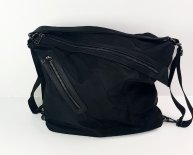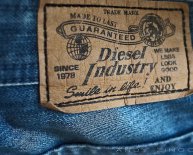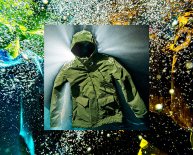
Twill fabric Construction
Leg twist is a serious problem in the manufacture of jeans, giving the appearance of a rotation of the legs in the opposite direction of the twill of the fabric after laundering. This invention relates to the avoidance of leg twist caused by unstabilized twill fabrics, usually medium to heavy weight cotton fabrics, used for slacks and jeans. Leg twist is believed to be the result of directional yarn stresses which are inherent in regular twill weave fabrics and thus introduced at the time of fabric construction and enduring until laundering, at which time relaxation of those yarn stresses result in a change of the angular relationship between warp and filling yarns, causing the legs to appear twisted. In certain instances, stresses are introduced into garments by sewing which also gives the leg "twist" appearance, but sewing stresses are outside the scope of this invention, which relates only to leg twist caused by fabric construction. Stabilized twill fabrics, such as permanent press finished, are usually outside the scope of this invention, because the relationship between yarns is chemically fixed. On the other hand, shrinkage stabilization (i.e. Sanforizing) is, of course, included since most cotton twill jeans and slacks are pre-shrunk. The described leg twist does not show on garments at the time of purchase, but only after the garments have been laundered. Leg twist appears after the first laundering and usually grows progressively worse with increased number of launderings. The volume of jeans manufactured from medium to heavy weight cotton twill fabrics, particularly from blue denim, has increased in recent years because of changing apparel buying habits which have created an unprecedented demand for jeans. As a result, the long-standing problem of leg twist, further accentuated by the flared leg bottoms which have been in fashion for several years, has become a substantial problem. It is estimated that the returns of jeans to manufacturers because of leg twist numbers in excess of one hundred thousand annually and that the number of dissatisfied customers who do not return jeans having leg twist exceeds that number by a factor of at least six. Some manufacturers have restored to broken twill weaves in order to avoid the problem of leg twist, but there is a very strong demand for jeans made of regular cotton twill fabrics.
It has been known that fabrics tend to skew during piece dyeing, preparation and finishing. For this purpose, devices such as fabric or weft straighteners have been developed which automatically sense any deviation from the perpendicular relationship between warp and filling yarns and automatically correct such deviation by differential straightening. In this way, registry of prints on fabrics, for example, can be maintained. However, such devices are intended to reduce deviation from the perpendicular state and are not intended to purposefully introduce skew into the fabrics. Commonly, fabric straighteners are used for knit fabrics which are then heat-set to give permanent straightness. Heretofore, any introduction of skew or deviation from the perpendicular relationship between warp and filling yarns in jean weight fabrics has been scrupulously avoided.
SUMMARY OF THE INVENTION
















